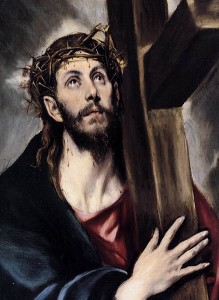
Today I will be going out to watch my village’s Good Friday procession which consists of mourners following men carrying a glass coffin in which a statue of Jesus Christ lies. It is a moving spectacle and I’m glad that it makes people stop and think about the sacrifice that Christ made and the suffering he went through.
In Medieval and Tudor times, before the Reformation saw the abolition of some rituals and traditions, people would attend a ceremony known as “Creeping to the Cross”. In local churches, the creeping would be carried out by the clergy, who would get down on their hands and knees and creep up to a crucifix held up before the altar. Once they got to the cross, they would kiss the feet of Christ and then the crucifix would be taken down and the congregation would also be allowed to kiss Christ’s feet. The monarch would also carry out this tradition, creeping to the cross and then also blessing metal with holy water so that it could be made into healing cramp rings to help with all kinds of ailments. Remember, the monarch was believed to have healing powers because s/he was God’s anointed sovereign. These healing powers also came into play in another Good Friday tradition, “Touching for the King’s Evil”, which was simply the monarch blessing, and hopefully healing, people with a touch.
We have a record of Mary I’s Easter rituals from 1556, which I wrote about in last year’s Good Friday article, but I’ll share them again here. Marco Antionio Faitta, the Venetian Ambassador, recorded Mary I washing the feet of 41 poor women on Maundy Thursday (the number equalling her age), giving alms and gifts and then, on Good Friday, creeping to the cross before blessing those afflicted with scrofula, a type of Tuberculosis:-
“But she chose to perform this act privately in a gallery where there were not above twenty persons. She caused one of the infirm women to be brought to her, when she knelt and pressed with her hands on the spot where the sore was. This she did to a man and three women. She then made the sick people come up to her again, and taking a gold coin – viz. an angel – she touched the place where the evil showed itself, signed it with the Cross and passed a ribbon through the hole which had been pierced in it, placing one of them round the neck of each of the patients, and making them promise never to part with that coin, save in case of extreme need.”
Faitta then goes on to describe Mary’s “humility and love of religion” as she carried out these traditional Easter rituals.
Good Friday was also the day on which the Easter Sepulchre was prepared. This was to represent Christ’s tomb, and the Tudor people would use a niche into which they put an image of Christ along with the consecrated host. This niche would then be ‘sealed’ with a cloth and candles would be placed around the niche and lit. Members of the congregation would then take it in turns to guard the Sepulchre, just as the Roman guards had guarded Christ’s tomb.
How do you commemorate Good Friday in your country or culture?
Anne Boleyn and Good Friday
Notes and Sources
- “Would I Could Give You Help and Succour”: Elizabeth I and the Politics of Touch, Carole Levin, University of Nebraska, 1989, Published in ALBION: A QUARTERLY JOURNAL CONCERNED WITH BRITISH STUDIES, Vol. 21, No. 2 (Summer, 1989), p197
- Pleasures and Pastimes in Tudor England, Alison Sim